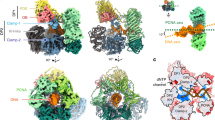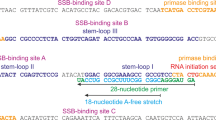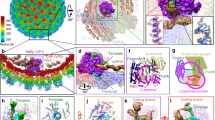Abstract
COLICIN E1 plasmid (Col E1) DNA usually exists as closed-circular duplex molecules of molecular weight 4.2×106 (ref. 1). In addition to the form that is assumed to contain only deoxyribonucleotides linked by phosphodiester bonds, two other types of supercoiled closed-circular molecules have been described. One is a DNA–protein complex, called a relaxation complex2. When the protein is denatured or destroyed, the complex is converted to an open-circular structure that has a break (a nick or a gap) in the heavy (H) strand (as defined by CsCl-poly(U,G) density gradient centrifugation)3. The other type is the closed-circular molecule that accumulates in bacteria when protein synthesis is inhibited and contains a sequence of ribonucleotides (RNA) generally in either the light or heavy strand4,5. The functions of these non-DNA components in replication of the plasmid have been the subject of speculation2,5. Recently, it was shown that Col E1 DNA replication initiates from a fixed region which is located approximately 20% of the molecular length from the single site of cleavage of endonuclease EcoR16–8. Replication proceeds unidirectionally6–8 and terminates at or near the origin of replication9. It was thus interesting to locate the interruption in a DNA strand resulting from either the removal of the relaxation protein or the hydrolysis of the RNA with respect to the origin/terminus region. By measuring the size by gel electrophoresis of DNA fragments formed by denaturation of linear molecules produced by the treatment of open-circular molecules containing a relaxation break with endonuclease EcoR1, the break was located at approximately 20% of the length from the end of the linear molecule10. We developed an electron microscopic method to determine the position of a single-stranded break and found that the relaxation break is located approximately 20% of the length from the end which has the 3′ end of the H strand of the linear molecule created by the treatment with endonuclease EcoR1. On the other hand the break caused by removal of RNA is distributed at random along the molecule. Hybridisation experiments with labelled DNA fragments which were made immediately after initiation of replication to the strands of Col E1 DNA treated successively with endonuclease EcoR1 and exonuclease III show that the relaxation break is located at the origin/terminus region.
This is a preview of subscription content, access via your institution
Access options
Subscribe to this journal
Receive 51 print issues and online access
$199.00 per year
only $3.90 per issue
Buy this article
- Purchase on Springer Link
- Instant access to full article PDF
Prices may be subject to local taxes which are calculated during checkout
Similar content being viewed by others
References
Bazaral, M., and Helinski, D. R., J. molec. Biol., 36, 185–194 (1968).
Clewell, D. B., and Helinski, D. R., Proc. natn. Acad. Sci. U.S.A., 62, 1159–1166 (1970).
Clewell, D. B., and Helinski, D. R., Biochemistry, 9, 4428–4440 (1970).
Blair, D. G., Sherratt, D. J., Clewell, D. B., and Helinski, D. R., Proc. natn. Acad. Sci. U.S.A., 69, 2518–2522 (1972).
Williams, P. H., Boyer, H. W., and Helinski, D. R., Proc. natn. Acad. Sci. U.S.A., 70, 3744–3748 (1973).
Tomizawa, J., Sakakibara, Y., and Kakefuda, T., Proc. natn. Acad. Sci. U.S.A., 71, 2260–2264 (1974).
Inselburg, J., Proc. natn. Acad. Sci. U.S.A., 71, 2256–2259 (1974).
Lovett, M. A., Katz, L., and Helinski, D. R., Nature, 251, 337–340 (1974).
Sakakibara, Y., and Tomizawa, J., Proc. natn. Acad. Sci. U.S.A. 71, 4935–4939 (1974).
Lovett, M., Guiney, D. G., and Helinski, D. R., Proc. natn. Acad. Sci. U.S.A., 71, 3854–3857 (1974).
Richardson, C. C., Lehman, I. R., and Kornberg, A., J. biol. Chem., 239, 251–258 (1964).
Sakakibara, Y., and Tomizawa, J., Proc. natn. Acad. Sci. U.S.A., 71, 802–806 (1974).
Sakakibara, Y., and Tomizawa, J., Proc. natn. Acad. Sci., 71, 1403–1407 (1974).
Oda, K., Sakakibara, Y., and Tomizawa, J., Virology, 39, 901–918 (1969).
Denhardt, D. T., Biochem. biophys. Res. Commun., 23, 641–646 (1966).
Keller, W., and Crouch, R., Proc. natn. Acad. Sci. U.S.A., 69, 3360–3364 (1972).
Richardson, C., Proc. nucleic acid Res., 2, 815–828 (1971).
Author information
Authors and Affiliations
Rights and permissions
About this article
Cite this article
SUGINO, Y., TOMIZAWA, JI. & KAKEFUDA, T. Location of non-DNA components of closed circular colicin E1 plasmid DNA. Nature 253, 652–654 (1975). https://doi.org/10.1038/253652a0
Received:
Revised:
Published:
Issue Date:
DOI: https://doi.org/10.1038/253652a0
This article is cited by
-
A complementation analysis of mobilization deficient mutants of the plasmid colE1
Molecular and General Genetics MGG (1979)
-
Two distinct mechanisms of synthesis of DNA fragments on colicin E1 plasmid DNA
Nature (1975)
Comments
By submitting a comment you agree to abide by our Terms and Community Guidelines. If you find something abusive or that does not comply with our terms or guidelines please flag it as inappropriate.



